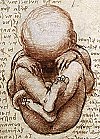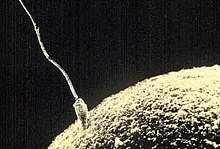| Part of a series on |
| Human growth and development |
|---|
 |
| Stages |
| Biological milestones |
| Development and psychology |
Human development is the process of growing to maturity. In biological terms, this entails growth from a one-celled zygote to an adult human being.
Biological development
Antenatal

Fertilization occurs when the sperm successfully enters the ovum's membrane. The chromosomes of the sperm combine with those of the egg to form a single cell, called a zygote, and the germinal stage of prenatal development commences.[1] The germinal stage refers to the time from fertilization, through the development of the early embryo, up until implantation. The germinal stage is over at about 10 days of gestation.[2]
The zygote contains a full complement of genetic material and develops into the embryo. Briefly, embryonic developments have four stages: the morula stage, the blastula stage, the gastrula stage, and the neurula stage. Prior to implantation, the embryo remains in a protein shell, the zona pellucida, and undergoes a series of cell divisions, called mitosis. A week after fertilization the embryo still has not grown in size, but hatches from the zona pellucida and adheres to the lining of the mother's uterus. This induces a decidual reaction, wherein the uterine cells proliferate and surround the embryo thus causing it to become embedded within the uterine tissue. The embryo, meanwhile, proliferates and develops both into embryonic and extra-embryonic tissue, the latter forming the fetal membranes and the placenta. In humans, the embryo is referred to as a fetus in the later stages of prenatal development. The transition from embryo to fetus is arbitrarily defined as occurring 8 weeks after fertilization. In comparison to the embryo, the fetus has more recognizable external features and a set of progressively developing internal organs. A nearly identical process occurs in other species.
Physical stages
The following are some approximate age ranges for physical development stages:

- Prenatal (sperm fertilizes egg – birth)
- Embryo (fertilization – 8 weeks after fertilization)
- Zygote, the single cell stage which occurs after fertilization
- Blastocyst, the stage prior to implantation, when the embryo is a hollow sphere
- Post-implantation embryo, the period 1–8 weeks after fertilization (3 to 10 weeks' gestation)
- Fetus, (10th week of pregnancy – birth)
- Embryo (fertilization – 8 weeks after fertilization)
Postnatal
Infancy and childhood
- Prepubescence (This matches with the social stage of childhood, Typically 0-11 years)
- Neonate (newborn) (0–28 days)
- Infant (baby) (1 month – 12 months)
- Toddler (1–2 years)
- Play age (3–5 years)
- Elementary school age (6–8)
- Preadolescence (The child in this and the previous phase are called schoolchild (schoolboy or schoolgirl), when still of primary school age.) (9–11 years)

The Tanner stages can be used to approximately judge a child's age based on physical development.
Puberty
- Pubescence (This is the biological stage where puberty has begun but not completed. This lines up socially with the start of adolescence. Typically 11-14 years)
- adrenarche (approximately age 11)
- gonadarche (approximately age 12)
- thelarche (approximately age 12 in females)
- pubarche (approximately age 12)
- menarche (approximately age 12.5 in females)
- spermarche (approximately age 13.5 in males)
After puberty
- Postpubescence (This is the biological stage after puberty has been completed. This lines up socially with mid-adolescence and later adulthood. Typically 14 years to death)
- "Young" adulthood, where puberty has ended but growth of features such as hair and bones continues to some extent as the body is trying to end the growth. (Roughly ages 14-22 in males, much shorter in females)
- Adulthood, where the body has succeeded in ending all growth of bones and other features.
Development of human organ systems
| This article is part of a series on the |
| Development of organ systems |
|---|
Development of the various human organ systems is complex with interaction between systems occurring but :
- Pre-teenager (10–12)
- Teenager (13–19)
- Twentysomething (20–29)
- Thirtysomething (30–39)
- Fortysomething (40–49)
- Fiftysomething (50–59)
- Sixtysomething (60–69)
- Seventysomething (70–79)
- Eightysomething (80–89)
- Ninetysomething (90–99)
- Centenarian (100–109)
- Supercentenarian (110+)
See also
Footnotes
- ^ Sherk, Stephanie Dionne. "Prenatal Development". Gale Encyclopedia of Children's Health, 2006. Gale. Archived from the original on 1 December 2013. Retrieved 6 October 2013.
{{cite web}}: Unknown parameter|deadurl=ignored (|url-status=suggested) (help) - ^ "germinal stage". Mosby's Medical Dictionary, 8th edition. Elsevier. Retrieved 6 October 2013.